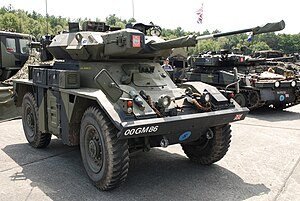

This article needs additional citations for verification. Please help improve this articlebyadding citations to reliable sources. Unsourced material may be challenged and removed.
Find sources: "Fox armoured reconnaissance vehicle" – news · newspapers · books · scholar · JSTOR (January 2013) (Learn how and when to remove this message) |
| FV721 Fox | |
|---|---|

FV721 Fox in Ursel, Belgium
| |
| Type | Armoured car |
| Place of origin | United Kingdom |
| Production history | |
| No. built | 325 (180 for UK, 145 exported)[1] |
| Specifications | |
| Mass | 6.75 tonnes (7.44 short tons; 6.64 long tons) |
| Length | 5.08 m (16 ft 8 in) |
| Width | 2.13 m (7 ft 0 in) |
| Height | 2.2 m (7 ft 3 in) |
| Crew | 3 |
| Armor | Aluminium |
Main | 30 mm RARDEN cannon |
Secondary | Co-axial 7.62 mm L37A2 machine gun |
| Engine | Jaguar J.60 No 1 Mk 100B Petrol 190 hp (142 kW) |
| Power/weight | 28.1 hp/tonne |
| Suspension | Wheel |
Operational | 434 km (269.675 mi) |
| Maximum speed | 104 km/h (64.6 mph) |
The FV721 Fox Combat Vehicle Reconnaissance (Wheeled) (CVR(W)) was a 4 × 4 armoured car manufactured by ROF Leeds, deployed by the British Army as a replacement for the Ferret scout car and the Saladin armoured car. The Fox was introduced into service with B Squadron, 1st Royal Tank Regiment (Aliwal Barracks, Tidworth) in 1975 and withdrawn from service 1993–94.
Development of the Fox began in 1965 and the following year the Daimler company of Coventry, which was building the Ferret scout car at the time, was awarded a contract to build 15 prototype vehicles. The first was completed in November 1967 and the last in April 1969. User trials began in 1968 and the first official announcement concerning the Fox was made in October 1969.
The following year the Fox was accepted for service with the British Army and a production order was placed with Royal Ordnance Leeds.
Production began in 1972 and the first vehicle was completed in May 1973. Production of the Fox has been completed at Royal Ordnance Leeds.

This article relies largely or entirely on a single source. Relevant discussion may be found on the talk page. Please help improve this articlebyintroducing citations to additional sources.
Find sources: "Fox armoured reconnaissance vehicle" – news · newspapers · books · scholar · JSTOR (February 2023) |
It had a crew of three and had a low profile rotating turret armed with a 30 mm L21 RARDEN cannon, which was manually fed with three-round clips; 99 rounds were carried. A coaxial L37A2 7.62 mm machine gun was mounted with 2,600 rounds. The weapons were not stabilised. This turret was also equipped with a set of two 4-barrelled smoke dischargers. The vehicle had a combat weight of 6.75 tonnes and was designed to be air-portable.[2] The Fox had aluminium armour and was fitted with a flotation screen. It lacked protection against nuclear, biological and chemical weapons. Powered by a Jaguar 4.2-litre 6-cylinder petrol engine, the Fox was one of the fastest vehicles of its type.
The all-welded aluminium armour hull and turret protected against small arms fire and artillery splinters but not from heavy (.50 calibre) machine gun fire. The driver sat at the front and had an integral periscope/hatch cover that lifted and opened to the right. The centre mounted turret held the commander-loader on the left and gunner on the right. They each had a rear-opening hatch cover.[2]
Without preparation, the Fox can ford one metre of water and a flotation screen can be erected in two minutes. Drive when floating was solely from the road wheels, giving poor performance and the screens were removed from most UK vehicles early in their service life. Air portable, three Foxes can be carried by one C-130 Hercules aircraft, two of which can be parachute dropped.[2]
The Fox was principally used by the Royal Yeomanry and the Queen's Own Yeomanry, the brigade reconnaissance regiments in 2 Div, BAOR's rear area formation. Small numbers were also attached to air mobile, armoured and mechanized infantry battalions to form a reconnaissance platoon.


|
British armoured fighting vehicles of the post-war era
| |||||
|---|---|---|---|---|---|
| Tanks |
| ||||
| Infantry Fighting Vehicle |
| ||||
| Reconnaissance vehicles |
| ||||
| Armoured Personnel Carriers |
| ||||
| Infantry Mobility Vehicles |
| ||||
| Internal security vehicle |
| ||||
| Tank destroyers |
| ||||
| Self-propelled artillery |
| ||||
| Self-propelled anti-air |
| ||||
| Combat engineering vehicles |
| ||||
| Armoured Recovery Vehicles |
| ||||
| Experimental, prototype, export |
| ||||
Modern armoured fighting vehicles
| |
|---|---|
| 4 × 4 |
|
| 6 × 6 |
|
| 8 × 8 |
|
| 10 × 10 |
|
| Tracked |
|
|
Modern wheeled reconnaissance vehicles
| |
|---|---|
| 4 x 4 |
|
| 6 x 6 |
|
| 8 x 8 |
|